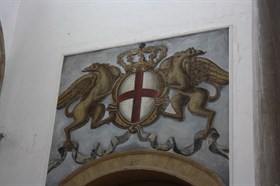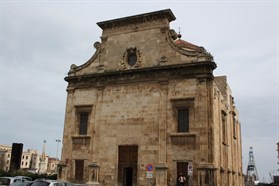A rich and powerful community
 During the Early Modern period, the need to raise money, in particular to finance the growing costs of war, brought the sovereigns of Europe to follow different paths to secure revenue and funding. Alongside the increase in the tax burden on people and especially as a phenomenon typical of the French monarchy such as the venality of offices, debt was the instrument that most sovereign republics and local communities, as early as the last centuries of the Middle Ages, made use of. The municipalities of northern Italy, Flanders and Germany introduced a form of debt based on the trust of citizens-investors: debt consolidation, which consisted in issuing government bonds that guaranteed a fixed and safe annuity (usually oscillating between 7 and 10 percent) generated by specific tax revenues. However, if for Italian municipalities such as Venice and Florence, devoid of large land estates, “public” debt constituted a strategy which was almost obligatory, for the great sovereigns of Europe, and in particular for the King of Spain, the increased need for money lead to forms of borrowing which were much more expensive. As early as the thirteenth century powerful companies of merchant-bankers were born, able to guarantee loans of large sums of cash on a short- term basis with a high interest rate. Through bills of exchange, such sums of money could travel safely through Europe, where they could be cashed in or paid at exchange fairs.
During the Early Modern period, the need to raise money, in particular to finance the growing costs of war, brought the sovereigns of Europe to follow different paths to secure revenue and funding. Alongside the increase in the tax burden on people and especially as a phenomenon typical of the French monarchy such as the venality of offices, debt was the instrument that most sovereign republics and local communities, as early as the last centuries of the Middle Ages, made use of. The municipalities of northern Italy, Flanders and Germany introduced a form of debt based on the trust of citizens-investors: debt consolidation, which consisted in issuing government bonds that guaranteed a fixed and safe annuity (usually oscillating between 7 and 10 percent) generated by specific tax revenues. However, if for Italian municipalities such as Venice and Florence, devoid of large land estates, “public” debt constituted a strategy which was almost obligatory, for the great sovereigns of Europe, and in particular for the King of Spain, the increased need for money lead to forms of borrowing which were much more expensive. As early as the thirteenth century powerful companies of merchant-bankers were born, able to guarantee loans of large sums of cash on a short- term basis with a high interest rate. Through bills of exchange, such sums of money could travel safely through Europe, where they could be cashed in or paid at exchange fairs.
 If initially the Sienese and Florentines dominated the financial market in Europe in the thirteenth and fourteenth century, new groups emerged during the Early Modern period. In the specific case of the Spanish Monarchy, the German Függers became the main financiers of the war efforts of Charles V, but even in the last fifteen years of the reign of the Emperor, and then even more so under Philip II and Philip III it was Genoese bankers who guaranteed the most important and lucrative loans (asientos) to Iberian kings. The Genoese merchants and explorers had in fact been skillful in building an efficient credit network with the Iberian world, France and Northern Europe, getting to the point of hosting their own exchange fairs, as an alternative to those of Lyons and other centers: in Becançon and, starting from 1579, in Piacenza. The economic and political power of the Genoese, and in particular families such the DoriaThe Doria, or the D’Oria family, is one of the most important aristocratic families in Italy’s history. Originally from Genoa, the first traces of the Doria go back to the tenth century. Among the various members of the family, were the admirals Lamba (1245-1323), Andrea (1466-1560) and Gianandrea (1539-1606) and the Cardinals Girolamo, Giovanni, Sinibaldo and Giorgio. The Marquis and Princes of Torriglia, the Doria are divided into several branches, one of the most famous of which is that of Doria-Pamphili. The current mayor of Genoa, Marco Doria, descended from a branch of the family., SpinolaThe Spinola are one of the oldest and most important families in the history of Genoa, traditional leaders in the political life of the city. Lined up alongside the Ghibelline Doria during the fourteenth century, the Spinola were enriched over the centuries through trade, banking activities and the acquisition of property. Among its leaders there was General Ambrogio Spinola (1569-1630), the great man of arms in the service of the King of Spain., GrimaldiThe Grimaldi are one of the oldest and most important families in the history of Genoa, on the same level as the Doria, Spinola, Fieschi and Imperiale. Merchants, bankers and big landowners, the various branches of the family amassed major titles as dukes, marquises and princes, such as those of Gerace, Salerno and Antibes. Albert II Grimaldi is the current ruler of the Principality of Monaco. and the CenturioneEven the Centurione were among the Genoese families who enriched themselves greatly from the fourteenth century onwards, first through trade and then with banking, providing loans of large sums of money in particular to the King of Spain. In 1602, a member of the family, Ottavio, guaranteed the so-called asiento grande, a record loan of almost 9 million ducats to Philip III of Habsburg., was enough to push historians to coin the expression the “Century of the Genoese” (1530ca.-1630ca.). During the reign of Philip IV, their influence began to wane, due to the competition of Portuguese bankers, but also to a progressive loss of investor confidence in the Habsburg Monarchy, often forced to resort to suspension of payments (in 1557, 1575, 1596, 1607, 1627, 1647, 1653) to renegotiate interest rates or to transform floating debt into consolidated accounts.
If initially the Sienese and Florentines dominated the financial market in Europe in the thirteenth and fourteenth century, new groups emerged during the Early Modern period. In the specific case of the Spanish Monarchy, the German Függers became the main financiers of the war efforts of Charles V, but even in the last fifteen years of the reign of the Emperor, and then even more so under Philip II and Philip III it was Genoese bankers who guaranteed the most important and lucrative loans (asientos) to Iberian kings. The Genoese merchants and explorers had in fact been skillful in building an efficient credit network with the Iberian world, France and Northern Europe, getting to the point of hosting their own exchange fairs, as an alternative to those of Lyons and other centers: in Becançon and, starting from 1579, in Piacenza. The economic and political power of the Genoese, and in particular families such the DoriaThe Doria, or the D’Oria family, is one of the most important aristocratic families in Italy’s history. Originally from Genoa, the first traces of the Doria go back to the tenth century. Among the various members of the family, were the admirals Lamba (1245-1323), Andrea (1466-1560) and Gianandrea (1539-1606) and the Cardinals Girolamo, Giovanni, Sinibaldo and Giorgio. The Marquis and Princes of Torriglia, the Doria are divided into several branches, one of the most famous of which is that of Doria-Pamphili. The current mayor of Genoa, Marco Doria, descended from a branch of the family., SpinolaThe Spinola are one of the oldest and most important families in the history of Genoa, traditional leaders in the political life of the city. Lined up alongside the Ghibelline Doria during the fourteenth century, the Spinola were enriched over the centuries through trade, banking activities and the acquisition of property. Among its leaders there was General Ambrogio Spinola (1569-1630), the great man of arms in the service of the King of Spain., GrimaldiThe Grimaldi are one of the oldest and most important families in the history of Genoa, on the same level as the Doria, Spinola, Fieschi and Imperiale. Merchants, bankers and big landowners, the various branches of the family amassed major titles as dukes, marquises and princes, such as those of Gerace, Salerno and Antibes. Albert II Grimaldi is the current ruler of the Principality of Monaco. and the CenturioneEven the Centurione were among the Genoese families who enriched themselves greatly from the fourteenth century onwards, first through trade and then with banking, providing loans of large sums of money in particular to the King of Spain. In 1602, a member of the family, Ottavio, guaranteed the so-called asiento grande, a record loan of almost 9 million ducats to Philip III of Habsburg., was enough to push historians to coin the expression the “Century of the Genoese” (1530ca.-1630ca.). During the reign of Philip IV, their influence began to wane, due to the competition of Portuguese bankers, but also to a progressive loss of investor confidence in the Habsburg Monarchy, often forced to resort to suspension of payments (in 1557, 1575, 1596, 1607, 1627, 1647, 1653) to renegotiate interest rates or to transform floating debt into consolidated accounts.
The presence of the Genoese in the main centers of the Spanish Monarchy is still attested to by the buildings, religious or otherwise, that the community built over the course of the Early Modern period. Churches dedicated to the cult of the patron saint of Genoa, Saint George (photo: Church of San Giorgio dei Genovesi in Palermo), or palaces and mansions are still part of the artistic heritage of various locations and still testify to the power and wealth of the Genoese community in the Baroque age.
